
Welcome to the Earth and Environmental Sciences Research Libguide!
This Libguide serves as a starting point of your research into the study of socio-cultural, environmental, geological and ecological systems as well as complex regional and global problems such as climate change, poverty, environmental degradation, and food and energy security. Research and publications collated in this space span diverse fields of geology, ecology, hydrology, environmental sciences, energy resources, and natural hazards. These resources are available through the UCA library system in print or online, and through external online sources.
The resources are organized into three main pages or tabs:
Welcome – this tab contains a brief introduction as well as boxes of key websites and journals on the left-hand side and featured books on the right-hand side. The cover page images of books and journals are shown to aid quick recognition and links are embedded for direct access.
Library Resources - this tab consists of three subtabs:
Open Sources – contains links to all kinds of related external open sources such as eBooks, e-journals, websites and software.
The library continues to update this guide with more important related internal and external resources.
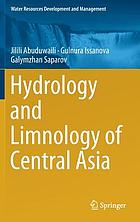 Hydrology and limnology of Central Asia
by
Water resources and impact of climate change on water resources in Central Asia -- Water resources in Kazakhstan -- Lakes in different regions of Kazakhstan -- Lakes in the Central Kazakhstan -- Morphometry and Genesis of lakes in Kazakhstan -- Water balance and Physical and chemical properties of water in lakes of Kazakhstan -- Lake and Sea Basins in Kazakhstan -- Water resources and Lakes in Kyrgyzstan -- Hydrographical and Physical-Geographical characteristics of the Issyk-Kul lake basin -- Use of water resources of the Issyk-Kul Lake Basin and Impact of climate change on it -- Water Resources and Lakes in Uzbekistan -- Water resources in Tajikistan -- Lakes in Xinjiang (Northwest China).
Hydrology and limnology of Central Asia
by
Water resources and impact of climate change on water resources in Central Asia -- Water resources in Kazakhstan -- Lakes in different regions of Kazakhstan -- Lakes in the Central Kazakhstan -- Morphometry and Genesis of lakes in Kazakhstan -- Water balance and Physical and chemical properties of water in lakes of Kazakhstan -- Lake and Sea Basins in Kazakhstan -- Water resources and Lakes in Kyrgyzstan -- Hydrographical and Physical-Geographical characteristics of the Issyk-Kul lake basin -- Use of water resources of the Issyk-Kul Lake Basin and Impact of climate change on it -- Water Resources and Lakes in Uzbekistan -- Water resources in Tajikistan -- Lakes in Xinjiang (Northwest China).
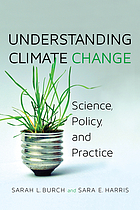 Understanding climate change : science, policy, and practice
by
"Conversations about climate change are filled with challenges involving complex data, deeply held values, and political issues. Understanding Climate Change provides readers with a concise, accessible, and holistic picture of the climate change problem, including both the scientific and human dimensions. Understanding Climate Change examines climate change as both a scientific and a public policy issue. Sarah L. Burch and Sara E. Harris explain the basics of the climate system, climate models and prediction, and human and biophysical impacts, as well as strategies for reducing greenhouse gas emissions, enhancing adaptability, and enabling climate change governance. The authors examine the connections between climate change and other pressing issues, such as human health, poverty, and other environmental problems, and they explore the ways that sustainable responses to climate change can simultaneously address those issues. An effective and integrated introduction to an urgent and controversial issue, Understanding Climate Change contains the tools needed for students, instructors, and decision-makers to become constructive participants in the human response to climate change."--Publisher's description
Understanding climate change : science, policy, and practice
by
"Conversations about climate change are filled with challenges involving complex data, deeply held values, and political issues. Understanding Climate Change provides readers with a concise, accessible, and holistic picture of the climate change problem, including both the scientific and human dimensions. Understanding Climate Change examines climate change as both a scientific and a public policy issue. Sarah L. Burch and Sara E. Harris explain the basics of the climate system, climate models and prediction, and human and biophysical impacts, as well as strategies for reducing greenhouse gas emissions, enhancing adaptability, and enabling climate change governance. The authors examine the connections between climate change and other pressing issues, such as human health, poverty, and other environmental problems, and they explore the ways that sustainable responses to climate change can simultaneously address those issues. An effective and integrated introduction to an urgent and controversial issue, Understanding Climate Change contains the tools needed for students, instructors, and decision-makers to become constructive participants in the human response to climate change."--Publisher's description
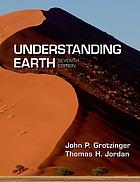 Understanding Earth
by
Understanding Earth is designed to bring the worldview of the working geologist to an audience new to learning about science. Students aren't merely presented with concepts and processes - they come to learn how we know what we know, and how that knowledge impacts their lives as citizens and helpful environmental stewards of the planet.
Understanding Earth
by
Understanding Earth is designed to bring the worldview of the working geologist to an audience new to learning about science. Students aren't merely presented with concepts and processes - they come to learn how we know what we know, and how that knowledge impacts their lives as citizens and helpful environmental stewards of the planet.
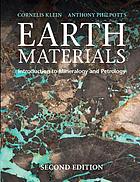 Earth materials : introduction to mineralogy and petrology
by
"This concise, accessible, market-leading textbook brings together the wide-ranging fundamentals students need to understand rocks and minerals, and shows them how they relate to the broader Earth, materials and environmental sciences. Designed specifically for one-semester courses, it is beautifully illustrated to explain the key concepts in mineralogy and petrology. This edition has been fully updated based on classroom experience, and new features include a completely new chapter providing an elementary introduction to thermodynamics, kinetics, radioactive decay and absolute dating; new mineral descriptions and many new stunning color photographs; and a new section on hydraulic fracturing and discussion of some of its most serious potential environmental consequences. The book uses stunning photos of mineral specimens and rock thin sections to help students build a core understanding. It also creates a highly effective learning experience through close integration of clear illustrations with engaging text, and helps students to easily visualize crystal structures through the CrystalViewer's 3D software, available online"-- Provided by publisher."This concise, accessible, market-leading textbook brings together the wide-ranging fundamentals students need to understand rocks and minerals, and shows them how they relate to the broader Earth, materials and environmental sciences. Designed specifically for one-semester courses, it is beautifully illustrated in full colour to explain the key concepts in mineralogy and petrology. This revision has been fully updated based on classroom experience. Including a completely new chapter providing an elementary introduction to thermodynamics, kinetics, radioactive decay and absolute dating, this new edition also features new mineral descriptions and many new stunning color photographs. A new section on hydraulic fracturing and discussion of some of its most serious potential environmental consequences has also been added. Stunning photos of mineral specimens and rock thin sections help students build a core understanding, whilst close intergration of clear illustrations with engaging text create a highly effective learning experience"-- Provided by publisher.
Earth materials : introduction to mineralogy and petrology
by
"This concise, accessible, market-leading textbook brings together the wide-ranging fundamentals students need to understand rocks and minerals, and shows them how they relate to the broader Earth, materials and environmental sciences. Designed specifically for one-semester courses, it is beautifully illustrated to explain the key concepts in mineralogy and petrology. This edition has been fully updated based on classroom experience, and new features include a completely new chapter providing an elementary introduction to thermodynamics, kinetics, radioactive decay and absolute dating; new mineral descriptions and many new stunning color photographs; and a new section on hydraulic fracturing and discussion of some of its most serious potential environmental consequences. The book uses stunning photos of mineral specimens and rock thin sections to help students build a core understanding. It also creates a highly effective learning experience through close integration of clear illustrations with engaging text, and helps students to easily visualize crystal structures through the CrystalViewer's 3D software, available online"-- Provided by publisher."This concise, accessible, market-leading textbook brings together the wide-ranging fundamentals students need to understand rocks and minerals, and shows them how they relate to the broader Earth, materials and environmental sciences. Designed specifically for one-semester courses, it is beautifully illustrated in full colour to explain the key concepts in mineralogy and petrology. This revision has been fully updated based on classroom experience. Including a completely new chapter providing an elementary introduction to thermodynamics, kinetics, radioactive decay and absolute dating, this new edition also features new mineral descriptions and many new stunning color photographs. A new section on hydraulic fracturing and discussion of some of its most serious potential environmental consequences has also been added. Stunning photos of mineral specimens and rock thin sections help students build a core understanding, whilst close intergration of clear illustrations with engaging text create a highly effective learning experience"-- Provided by publisher.
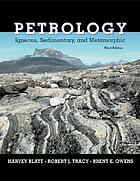 Petrology : igneous, sedimentary, and metamorphic.
by
"Now in a thoroughly updated new edition (the first since 1995), Petrology remains . . . [a] student-friendly undergraduate level text covering all three major rock groups. As always, the new edition organizes a vast body of literature from its wide-ranging subject, presenting what is essential to geology majors in a way that is accessible and at an appropriate level. The new edition welcomes Brent Owens as the new lead author for the chapters on igneous rocks, complementing Harvey Blatt's role for the sedimentary chapters, and Robert Tracy's for the metamorphic chapters." -- Publisher's description
Petrology : igneous, sedimentary, and metamorphic.
by
"Now in a thoroughly updated new edition (the first since 1995), Petrology remains . . . [a] student-friendly undergraduate level text covering all three major rock groups. As always, the new edition organizes a vast body of literature from its wide-ranging subject, presenting what is essential to geology majors in a way that is accessible and at an appropriate level. The new edition welcomes Brent Owens as the new lead author for the chapters on igneous rocks, complementing Harvey Blatt's role for the sedimentary chapters, and Robert Tracy's for the metamorphic chapters." -- Publisher's description
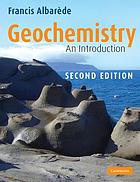 Geochemistry : an introduction
by
Introducing the essentials of modern geochemistry for students across the Earth and environmental sciences, this new edition emphasises the general principles of this central discipline. Focusing on inorganic chemistry, Francis Albarède's refreshing approach is brought to topics that range from measuring geological time to the understanding of climate change. The author leads the student through the necessary mathematics to understand the quantitative aspects of the subject in an easily understandable manner. The early chapters cover the principles and methods of physics and chemistry that underlie geochemistry, to build the students' understanding of concepts such as isotopes, fractionation, and mixing. These are then applied across many of the environments on Earth, including the solid Earth, rivers, and climate, and then extended to processes on other planets. Three new chapters have been added – on stable isotopes, biogeochemistry, and environmental geochemistry. End-of-chapter student exercises, with solutions available online, are also included.
Geochemistry : an introduction
by
Introducing the essentials of modern geochemistry for students across the Earth and environmental sciences, this new edition emphasises the general principles of this central discipline. Focusing on inorganic chemistry, Francis Albarède's refreshing approach is brought to topics that range from measuring geological time to the understanding of climate change. The author leads the student through the necessary mathematics to understand the quantitative aspects of the subject in an easily understandable manner. The early chapters cover the principles and methods of physics and chemistry that underlie geochemistry, to build the students' understanding of concepts such as isotopes, fractionation, and mixing. These are then applied across many of the environments on Earth, including the solid Earth, rivers, and climate, and then extended to processes on other planets. Three new chapters have been added – on stable isotopes, biogeochemistry, and environmental geochemistry. End-of-chapter student exercises, with solutions available online, are also included.
